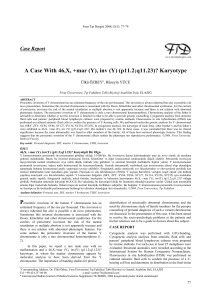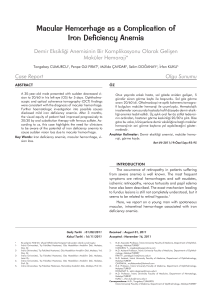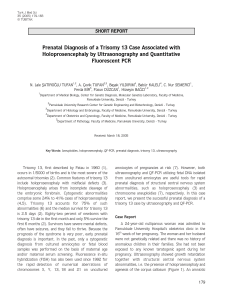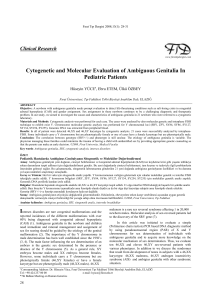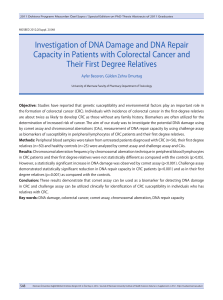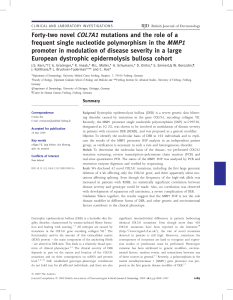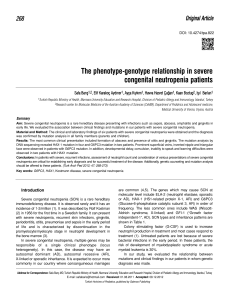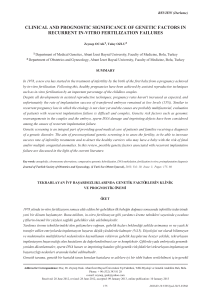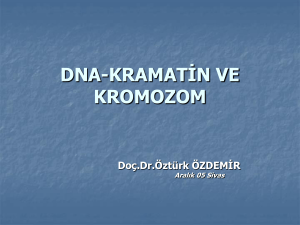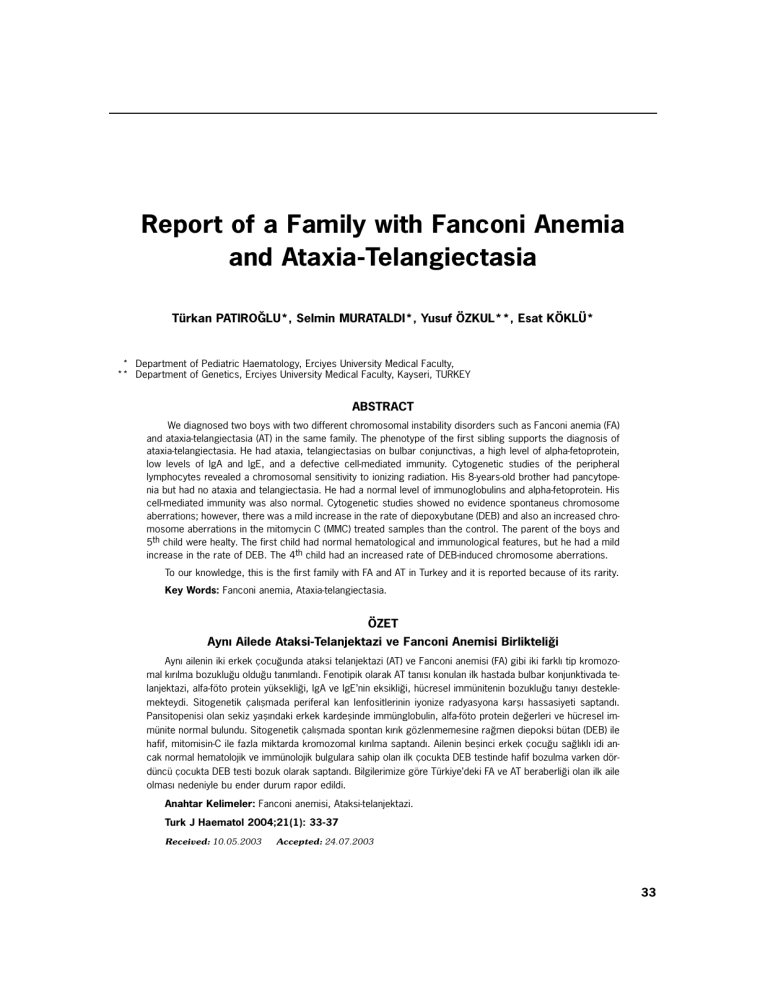
Report of a Family with Fanconi Anemia
and Ataxia-Telangiectasia
Türkan PATIRO⁄LU*, Selmin MURATALDI*, Yusuf ÖZKUL**, Esat KÖKLÜ*
* Department of Pediatric Haematology, Erciyes University Medical Faculty,
** Department of Genetics, Erciyes University Medical Faculty, Kayseri, TURKEY
ABSTRACT
We diagnosed two boys with two different chromosomal instability disorders such as Fanconi anemia (FA)
and ataxia-telangiectasia (AT) in the same family. The phenotype of the first sibling supports the diagnosis of
ataxia-telangiectasia. He had ataxia, telangiectasias on bulbar conjunctivas, a high level of alpha-fetoprotein,
low levels of IgA and IgE, and a defective cell-mediated immunity. Cytogenetic studies of the peripheral
lymphocytes revealed a chromosomal sensitivity to ionizing radiation. His 8-years-old brother had pancytopenia but had no ataxia and telangiectasia. He had a normal level of immunoglobulins and alpha-fetoprotein. His
cell-mediated immunity was also normal. Cytogenetic studies showed no evidence spontaneus chromosome
aberrations; however, there was a mild increase in the rate of diepoxybutane (DEB) and also an increased chromosome aberrations in the mitomycin C (MMC) treated samples than the control. The parent of the boys and
5th child were healty. The first child had normal hematological and immunological features, but he had a mild
increase in the rate of DEB. The 4th child had an increased rate of DEB-induced chromosome aberrations.
To our knowledge, this is the first family with FA and AT in Turkey and it is reported because of its rarity.
Key Words: Fanconi anemia, Ataxia-telangiectasia.
ÖZET
Ayn› Ailede Ataksi-Telanjektazi ve Fanconi Anemisi Birlikteli¤i
Ayn› ailenin iki erkek çocu¤unda ataksi telanjektazi (AT) ve Fanconi anemisi (FA) gibi iki farkl› tip kromozomal k›r›lma bozuklu¤u oldu¤u tan›mland›. Fenotipik olarak AT tan›s› konulan ilk hastada bulbar konjunktivada telanjektazi, alfa-föto protein yüksekli¤i, IgA ve IgE’nin eksikli¤i, hücresel immünitenin bozuklu¤u tan›y› desteklemekteydi. Sitogenetik çal›flmada periferal kan lenfositlerinin iyonize radyasyona karfl› hassasiyeti saptand›.
Pansitopenisi olan sekiz yafl›ndaki erkek kardeflinde immünglobulin, alfa-föto protein de¤erleri ve hücresel immünite normal bulundu. Sitogenetik çal›flmada spontan k›r›k gözlenmemesine ra¤men diepoksi bütan (DEB) ile
hafif, mitomisin-C ile fazla miktarda kromozomal k›r›lma saptand›. Ailenin beflinci erkek çocu¤u sa¤l›kl› idi ancak normal hematolojik ve immünolojik bulgulara sahip olan ilk çocukta DEB testinde hafif bozulma varken dördüncü çocukta DEB testi bozuk olarak saptand›. Bilgilerimize göre Türkiye’deki FA ve AT beraberli¤i olan ilk aile
olmas› nedeniyle bu ender durum rapor edildi.
Anahtar Kelimeler: Fanconi anemisi, Ataksi-telanjektazi.
Turk J Haematol 2004;21(1): 33-37
Received: 10.05.2003
Accepted: 24.07.2003
33
Pat›ro¤lu T, Muratald› S, Özkul Y, Köklü E.
INTRODUCTION
Genetic instability disorders of humans
include ataxia-telangiectasia (AT), Bloom
syndrome (BS), Fanconi anemia (FA), xeroderma pigmentosum and Nijmegen breakage
syndrome, all of which are very rare and inherited in a recessive manner. These syndromes
associated with an increased sensitivity to
certain DNA damaging agents where no defect
in DNA repair has been defined include FA
(sensitivity to DNA croos-link agents), hereditary dysplastic nevus syndrome (sensitivity to
ultraviolet) and AT (sensitivity to ionizing radiation)[1]. The production of DNA damage by
physical or chemical agents is dose-dependent. The error free enzymatic repair process
including excission resynthesis of base damage or of altered nucleotides allow reinstitution
of intact DNA. Absence of repair leads to cytotoxicity and programmed cell death cycle
control lead to a pretumoral state[2]. The incidence of cancers or malignant blood disease is
high[3].
We present here the cases with two different chromosomal instability disorders such
as FA and AT among members of the same
family because of its rarity.
CASE REPORTS
Case 1
A 12-years-old boy was admitted to the
pediatric department because of progressive
pulmonary infection and diarrhea. His parents were first cousins. His past history releaved that he had recurrent respiratory infection, he walked at three years of age and
had ataxia. He was not vaccinated. Physical
examination showed a severly malnourished
boy weighing 17.5 kg (< 3rd percentile) and
height 121 cm (< 3rd percentile). He had bilateral nystagmus, strabismus and telangiectasias in the bulbar conjunctivas, on the
bridge of the nose and on the ears. He had
suppurative otitis media and rales on the
lung. He had choreoatetoid movements and
dysconjugate gaze. With striking hypotonia
and generalized muscle weakness.
34
Report of a Family with Fanconi Anemia and Ataxia-Telangiectasia
The hemoglobin was 11.6 g/dL; white blood cell (WBC) count 23.300/mm3; platelets
470.000/mm3; mean corpuscular volume 67 fl.
Urine analysis, liver and renal function tests
were normal. He had a high level of alpha-fetoprotein (217.4 mg/dL). The level of IgG in the
serum was 949 mg/dL; IgA was 6.4 mg/dL;
IgM was 152 mg/dL; IgE was 8 mg/dL. He had
no IgG subclass deficiency. His chest radiography showed infiltrates in the both lungs.
PPD reaction was negative. He had diminished response of peripheral blood lymphocytes to PHA. Cytogenetic studies of the peripheral lymphocytes releaved a chromosomal
sensitivity to ionizing radiation when compared with the normal control, no increase in
the rate of DEB and MMC-induced chromosome aberrations (Table 1).
Case 2
A 8-years-old boy was admitted to the pediatric hematology department because of
severe ecchymosis, epistaxis and weight loss
for two months. His past history releaved
Table 1. Hematologic, immunologic and cytogenetic features of case 1 and 2
Hemoglobin (g/dl)
WBC
(/mm3)
Case 1
Case 2
11.6
4.3
12.300
2.200
470.000
26.000
MCV (fl)
67.9
112.3
MCH (pg)
21.7
36.5
RDW (%)
16.1
17.2
α-FP (ng/mL)
217.4
9.5
Platelets (/mm3)
13.8
Hb F (%)
IgG (mg/dL)
949
574
IgA (mg/dL)
6.4
131
IgM (mg/dL)
152
35
IgE (mg/dL)
18
169
Diepoxybutane
(-)
Borderline
MMC-induced breakage
(-)
(+)
Sensitivity to ionizing radiation (+)
(-)
Turk J Haematol 2004;21(1):33-37
Report of a Family with Fanconi Anemia and Ataxia-Telangiectasia
that he had no recurrent sinopulmonary infection. Physical examination showed that he
was pale and he had cafe-au-lait spots and
hyperpigmentation on his skin. He weighed
22 kg (< 3rd percentile) and was 120 cm (<
3rd percentile). His head circumference was
48.5 cm (< 3rd percentile). He had bilateral
microcornea and no hepatosplenomegaly
and lymphadenopathy. It was revealed that
he had no cardiac and renal abnormality.
The hemoglobin was 4.3 g/dL; WBC count
2200/mm3; platelets 26.000/mm3; MCV 104
fl; MCH 35.7 pg; MCHC 34.2 g/dL. Peripheral
blood and bone marrow smears showed no
blastic cells. He had a hypoplastic bone marrow. Alpha-fetoprotein level was 9.5 mg/dL.
He had a normal level of IgG, IgA, IgM and
IgE. His cell-mediated immunity was also
normal. Cytogenetic studies showed that
higher frequency of spontaneous chromosome aberrations in the untreated cultur and
of induced aberration in the mitomycin C treated samples, than the normal control and
also there was a mild increase in the rate of
diepoxybutane (DEB). The patient was given
Pat›ro¤lu T, Muratald› S, Özkul Y, Köklü E.
3 mg/kg of oxymethalone and is still prepared
for bone marrow transplantation (Table 1).
As the two boys of the same family had
two different chromosomal instability disorders such as FA and AT, we investigated other members of the family. The parent and
5th child were healthy. The first boy had a
normal level of hemoglobin, WBC count, platelets, immunoglobulins and alpha-fetoprotein, but he had a mild increase in the rate of
DEB. The 4th child had an increased rate of
DEB-induced chromosome aberrations, a
normal level of α-FP and she had 4400/mm3
leukocyte count and 144.000/mm3 of platelets (Table 2) (Figure 1).
DISCUSSION
Genetic instability syndromes are defined
by either an increase of chromosomal breakage or increase of sister chromatid exchange number, or by an increase of the two.
Bloom’s syndrome, AT and FA are the main
components of this group[3].
The AT gene (ATM) is involved in a variety
of signal transduction patways that regulate
Table 2. Hematologic, immunologic and cytogenetic features of other family members
Mother
Father
1st child
4th child
5th child
Hemoglobin (g/dL)
12.4
16.4
12.0
11.9
11.9
WBC (/mm3)
5000
5800
7040
4400
5600
307.000
264.000
315.000
144.000
392.000
Platelets (/mm3)
MCV (fl)
81.3
87.0
81.6
100
78.3
MCH (pg)
26.9
28.3
26.7
34.5
25.9
RDW (%)
13.0
11.6
12.6
12.0
14.6
α−FP (ng/mL)
3.9
1.9
3.8
6.2
0.5
10.5
0.5
IgG (mg/dL)
1318
638
690
IgA (mg/dL)
180
53.4
35
IgM (mg/dL)
150
22.2
116
IgE (mg/dL)
43
304
75
Borderline
(+)
(-)
Hb F (%)
Diepoxybutane
Abdominal ultrasonography
Turk J Haematol 2004;21(1):33-37
Normal
35
Pat›ro¤lu T, Muratald› S, Özkul Y, Köklü E.
Report of a Family with Fanconi Anemia and Ataxia-Telangiectasia
Healthy
,
AT
Borderline DEB (+)
FA
DEB (+), progression to FA
Figure 1. Pedigree of the family.
the cellular response to normal proliferative
stimuli as well as the response to DNA damage, and the disruption of these signal transduction pathways provides an explanation
for AT characteristics such as ionizing radiation sensitivity, immunodeficiency, and infertility[4]. The peripheral lymphocytes of our
first case with AT releaved a chromosomal
sensitivity to ionizing radiation. Although the
first FA gene (FAC) was cloned over 9 years
ago, and a second FA gene (FAA) was cloned
in 1996, the biochemical function of FA proteins largerly remains a mystery[5]. The peripheral lymphocytes of our other case with
pancytopenia showed a mild increase in the
rate of DEB and an increased rate of MMCinduced chromosome aberrations. The eldest
brother of our cases had a borderline positivity of DEB test and their sister had an increased rate of DEB-induced chromosome
aberrations. DEB tests of the parent and 5th
child were negative. All of them did not have
the two different mutations (exon 43 deletion
36
and exon 37 3639 deletion T), previously
described in Turkish population with FA[6].
Li et al reported the family having major
features of two autosomal recessive preleukemic disease, AT and FA in 1978[7]. Then,
he diagnosed these family as ataxia-pancytopenia syndrome[8]. Furthermore, a 3-yearsold boy with cerebellar ataxia, idiopathic aplastic anemia was reported. Cytogenetic studies of peripheral lymphocytes releaved a
previosly described karyotype, 46,XY,t (1;20),
(p22;q13.3)[9].
Gonzalez-del Angel et al reported a Mexican girl who developed cerebellar ataxia at
age three years and pancytopenia at age 13
years[10].
We diagnosed two brothers with two different chromosomal instability disorders such
as FA and AT in the same family according to
clinical, immunological and cytogenetic features of these diseases. To our knowledge, this
is the first family with FA and AT in Turkey.
Turk J Haematol 2004;21(1):33-37
Report of a Family with Fanconi Anemia and Ataxia-Telangiectasia
REFERENCES
1.
2.
3.
4.
5.
6.
7.
Hansson J. Inherited defects in DNA repair and susceptibility to DNA-damaging agents. Toxicol Lett
1992;64-65:141-8.
Moustacchi E. Molecular mechanism of carcinogenesis: the role of systems of DNA repair. Bull Acad Natl
Med 1998;182:33-6.
Germain D, Bernheim A. Chromosome instability
syndromes. Sem Hop 1983;59:3065-79.
Needlman RD. Growth and development. In: Behrman, Kliegman, Jenson (eds). Nelson Textbook of
Pediatrics. 16th ed. Philadelphia: Saunders Co,
2000:23-61.
Auerbach AD, Verlander PC. Disorders of DNA replication and repair. Curr Opin Pediatr 1997;9:600-16.
Koc A, Pronk JC, Alikaşifoğlu M, Joenje H, Altay Ç.
Variable pathogenicity of exon 43 del (FAA) in four
Fanconi anemia patients within a consanguineous
family. Br J Haematol 1999;104:127-30.
Li FP, Potter NU, Buchanan GR, Vawter G, WhangPeng J, Rosen RB. A family with acute leukemia,
hypoplastic anemia and cerebellar ataxia: association with bone marrow C-monosomy. Am J Med
1978;65:933-40.
Turk J Haematol 2004;21(1):33-37
Pat›ro¤lu T, Muratald› S, Özkul Y, Köklü E.
8.
Li FP, Hecht F, Kaiser-McCaw B, Baranko PV, Potter NU. Ataxia-pancytopenia: syndrome of cerebellar ataxia, hypoplastic anemia, monosomy 7, and
acute myelogenous leukemia. Cancer Genet Cytogenet 1981;4:189-96.
9. Nagata M, Hara T, Sakamoto K, Ueada K. Aplastic
anemia associated with ataxia and chromosome translocation (1;20). Acta Haematol 1990;84:198-200.
10. Gonzalez-del Angel A, Cervera M, Gomez L, PerezVera P, Orozco L, Carnavale A, Del Castillo V. Ataxia-pancytopenia syndrome. Am J Med Genet
2000;90:252-4.
Address for Correspondence:
Türkan PATIROĞLU, MD
Department of Pediatric Hematology
Erciyes University Medical Faculty
38039, Kayseri, TURKEY
e-mail: [email protected]
37


